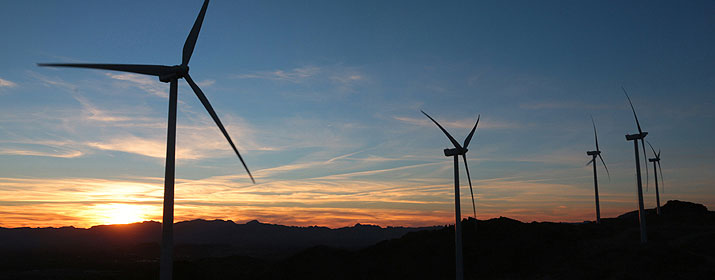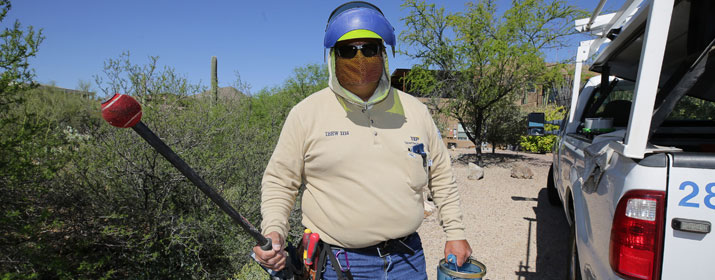
U.S. wind energy generating capacity has tripled over the past decade.
Wind is now the largest source of renewable energy in the country, and it will play an increasingly prominent role in Tucson Electric Power’s clean energy portfolio. We’re working to provide more than 70 percent of our power from wind and solar resources while reducing carbon emissions by 80 percent by 2035.
The changes in our portfolio will avoid the production of more than 50 million tons of carbon dioxide over the next 15 years – equivalent to removing three-quarters of a million cars off the road.
We currently have three wind farms in our portfolio: the 250 megawatt (MW) Oso Grande system in New Mexico, the 30 MW Red Horse system near Willcox, Ariz. and the 50 MW Macho Springs system near Deming, New Mexico. Our wind capacity will increase even more with the completion of the 99 MW Borderlands wind projects in New Mexico.
Did you know:
Construction of TEP’s largest renewable resource is now complete.
The 62 wind turbines on 24,000 acres southeast of Roswell, N.M. are now producing clean energy for our community. The site will generate enough power each year to serve the annual electric needs of nearly 100,000 homes. This single system doubled our large-scale renewable energy resources in 2021, representing a big step toward the cleaner, greener grid we’re building for our community.
Wind power can provide decades of zero-emission energy.
A wind turbine produces zero carbon emissions when it generates electricity and has one of the smallest carbon footprints among energy sources. In all, a typical wind project repays its carbon footprint in six months or less, according to the American Wind Energy Association and research published in the International Journal of Sustainable Manufacturing.
In 2019, the electricity generated from wind turbines avoided an estimated 42 million cars’ worth of CO2 emissions worldwide.
TEP expects Oso Grande to provide emissions-free energy for 30 years.
Wind and solar go together nicely.
Solar panels typically are most productive from late morning through early afternoon, but they don’t produce anything at night. That’s when wind resources can help.
Wind turbines typically produce more power during evening hours, extending the availability of clean energy for TEP customers.
New Mexico wind farms and Southern Arizona solar arrays also produce their peak output during different seasons, with solar peaking in the early spring and summer, while wind peaks in the winter and fall. Those seasonal differences allow for a more consistent availability of clean, green energy for customers throughout the year.
Wind power makes efficient use of land and conserves water.
From base to blade tip, the largest turbines in our Oso Grande project will reach more than 600 feet high – more than twice the height of the Statue of Liberty (305 feet) and taller than the Washington Monument (555 feet).
“It’s pretty impressive if you’ve never been around wind projects,” said Michael Bryan, Asset Manager for Oso Grande. “Everyone who comes out here is just in awe of the sheer size of the project and the turbines.”
Despite their massive size, wind turbines also have small footprints, leaving 98 percent of the land on a typical wind farm undisturbed. Oso Grande is being built on active cattle ranches where seven local ranchers continue to run their business.
Wind farms also help preserve water, which is an important resource in the desert. Unlike traditional power plants, wind turbines produce no emissions and don’t require water to generate electricity or to cool generating equipment.
In 2019, wind energy offset approximately 103 billion gallons of water use — the equivalent of 723 billion bottles of water, according to the American Wind Energy Association.
Wind power is a cost-effective solution to diversifying energy portfolios.
Not only does the typical hourly generation of wind serve as a strong complement to solar generation, but the levelized cost of energy from new wind farms has become more competitive as wind power has evolved.
The drop is attributed to declining capital costs and increasing capacity factors, according to the Electric Power Research Institute.
“Wind has really come a long way over the years since it was a relatively new technology,” Bryan said. “The efficiency of the turbines has increased dramatically and the levelized cost of electricity demonstrates that it can now compete with any other energy source out there. That wasn’t true 15 years ago.”






